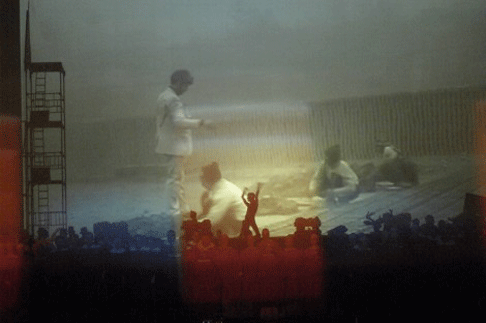Although the composer enjoyed widespread popularity in the mid-1920s with his
opera Die Vögel and religious works such as his Te Deum
which curried favour with the devout statesman Konrad Adenauer, Braunfels’
antagonism toward the Nazis and half-Jewish heritage led to a ban on his music
starting in 1933. It was not until 2001 that Jeanne D’Arc, written
at the height of the war between 1938-43, was unveiled to the public with a
concert performance in Stockholm starring Juliane Banse and conducted by
Manfred Honneck. Seven years later, the Deutsche Oper engaged the late
directing provocateur Christoph Schlingensief to conceive what would be the
opera’s staged premiere.
Often interpreted as a reaction to the brutality of the Holocaust,
Jeanne D’Arc expresses a desperate belief in the powers of the
divine to redeem the spiritually pure from the persecution of a society blinded
by false values. The French martyr and Catholic saint Joan of Arc had of course
already conjured operas by Giuseppe Verdi and Arthur Honegger, yet it was a
performance of Hindemith’s subversive Mathis der Maler that moved
Braunfels to pen his own libretto and carry forth with a religiously laden
opera. Choruses lifted from Passion oratorios intermingle with blocks of
extended tonality that evoke Wagner and Strauss without creating a hypnotic
sense of inebriation. The most interesting passages emerge in the unpredictable
harmonic development and sardonic trumpet fanfares at the start of the second
act that give full expression to Braunfels’ unassuaged frustration.
It is a shame that Schlingensief’s production, revived for three
performances this season and seen November 16, adopts an atheist critique of
western Christianity that is subsequently drowned in silly, morbid gags and
distracting video projections (executed with Anna-Sophie Mahler and Søren
Schuhmacher). Footage ranging from shots of a Nepalese village, where a
wreathed corpse is burned in a religious process, to the juxtaposition of
church boys with references to Mafia activity only misconstrues Braunfels’
simple allegory. Images of Schlingensief himself among the Nepalese and the
oversized anatomical set of lungs that descend downstage may make this staging
a fascinating historical document (the director died of lung cancer in 2010),
but he imposes more on this opera than he illuminates. Ultimately, it is hard
to justify the expense that went into the rotating stage’s convolution of
scenes (designs by Thomas George and Thekla von Müllheim).
A live cow emerges as an ostensible symbol for Johanna when the wife of the
Knight Baudricourt insists that she should be set free to bring an end to
pestilence in the village, accompanied by a nonsensical sign reading “Tote
Kuh fällt vom Schnurrbart” (the dead cow falls from its whiskers). Gaggles
of midgets in nun suits and projections of animal insides are enough to make
one cringe, but the distaste reaches its peak in an extra with cerebral palsy
who, dressed in a crown and gymnast’s suit (costumes by Aino Laberenz),
writhes in spasms with the music until he is smothered in fake blood and chokes
with suicidal gags for what felt like much too long. Although the character’s
symbolic presence as an extension of the King’s suffering eventually makes
itself clear, the exploitation of a disabled individual to this artistic end is
questionable at best. Schlingensief surely intended to make a statement in
favour of tolerance for all human beings, but his warped concept of social
activism only undermines the historical value of Braunfels’ opera. The
director also replaces some of the Inquisitor’s seminal lines with the spoken
words of a midget, such as the final “We have burned a holy being!” The
effect is perverse and detracts from the weight of the story. Just as
ridiculous is the moment when Joan of Arc emerges as a black-faced death angel
from an oversized birthday cake, only to light flickering candles as a symbol
of her burning at the stake.

Despite the tremendous stamina and purity of tone American soprano Mary
Mills brought to the title character, she was hampered by the stilted stage
concept. Rarely has there been a better example of Regietheater’s
power to undermine the presence of impeccable, if not so thespian-oriented,
musicianship. The rich-voiced English baritone Simon Neal gave a standout
performance as Joan’s ally, Gilles de Rais, and Kim-Lilian Strebel and Annie
Rosen made for a prettily sung, homogeneous pair as her female patron saints
Katharina and Margarete. In the role of St. Michael, the tenor Paul McNamara
gave an earnest delivery but suffered from a somewhat swallowed timbre; the
orchestra of the Deutsche Oper under Matthias Foremny also could have helped
matters by producing more restrained pianissimi.
Clemens Bieber made for an affecting King, even if one had to avert one’s
eyes from the cartoonish portrayal Schlingensief set out to achieve. Tobias
Kehrer gave a warm portrayal of Johanna’s father, Jacob, entering the stage
in bishop garb on a reindeer sled, and the nasal timbre of Paul Kaufmann made
for an appropriately pathetic portrait of the shepherd Colin. Jörg Schörner
gave a fine performance in the role of the sympathizing Duke of Alençon, while
Lenus Carlson made for an imposing Duke de la Trémouille. Yosep Kang also
stood out as Bertrand de Poulengy. The orchestra of the Deutsche Oper was stronger in soaring lyric lines than complex polyphony, with the brass especially smudged. The
house chorus also did not sound as rehearsed as usual despite its reliably
strong performance. Several seats were empty after intermission, a rare
occurrence in Berlin. Perhaps it would have made more sense to focus on this
musical specimen in concert performance, which is exactly what the Salzburg
Festival has planned for 2013.
Rebecca Schmid

